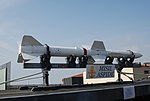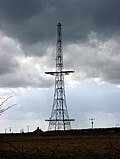An inverse monopulse seeker is a type of semi-active radar homing that offers significant advantages over earlier designs. The system requires electronics...
8 KB (1,356 words) - 17:05, 9 April 2024
Raytheon conical scanning seeker with a Marconi inverse monopulse seeker that worked with the F-4's radar. Monopulse seekers are more accurate, less susceptible...
8 KB (903 words) - 15:36, 28 February 2023
the early 1970s, the RAF developed the Skyflash version with an inverse monopulse seeker[citation needed] and improved motor, while the Italian Air Force...
32 KB (3,250 words) - 10:40, 2 June 2024
semi-active radar homing seeker. It is very similar to the American AIM-7 Sparrow, using the same airframe, but uses an inverse monopulse seeker that is far more...
12 KB (1,263 words) - 03:50, 16 June 2024
MiG-25. It has built in semi-active radar homing (R-40R), with an inverse monopulse seeker which give the missile ability to engage targets in all-aspects...
8 KB (686 words) - 16:57, 22 November 2023
beams. The antenna is mechanically rotated. Semi-active radar homing uses monopulse radar that relies on a fixed phased array to produce multiple adjacent...
46 KB (5,144 words) - 20:52, 3 June 2024
post-war radars, were matured in the late 1940s-early 1950s: pulse Doppler, monopulse, phased array, and synthetic aperture; the first three were known and...
151 KB (22,276 words) - 16:51, 14 May 2024
Guard's WMEC and WHEC ships can track one air or surface target using the monopulse tracker and two surface or shore targets. Oliver Hazard Perry-class frigates...
78 KB (10,711 words) - 17:59, 24 February 2024







